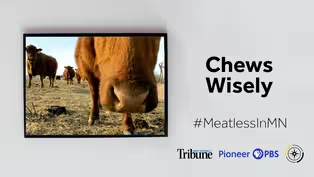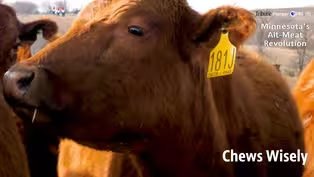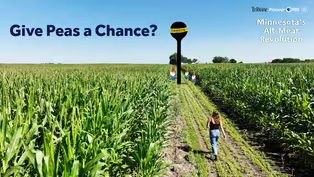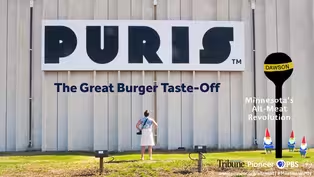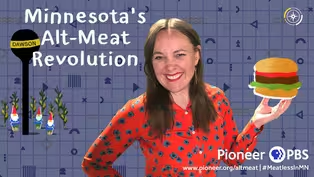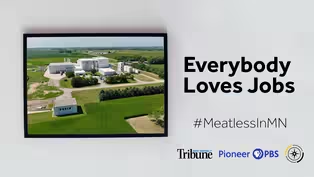Compass
Minnesota's Alt-Meat Revolution: The Smell of Money
Clip: Season 7 Episode 1 | 11m 51sVideo has Closed Captions
What can be learned by looking at Dawson’s early advances in the plant-based marketplace?
CORRECTION: The soy protein isolate building that Dawson Mills built was actually one mile outside of town, not 2.5 miles. -- Plant-based meat replacements are the food innovations of the 21st Century. But in Dawson, Minnesota, local industry has been plant based for over 70 years! What lessons can be learned by looking back to Dawson’s early advances in the plant-based marketplace?
Problems playing video? | Closed Captioning Feedback
Problems playing video? | Closed Captioning Feedback
Compass is a local public television program presented by Pioneer PBS
Compass
Minnesota's Alt-Meat Revolution: The Smell of Money
Clip: Season 7 Episode 1 | 11m 51sVideo has Closed Captions
CORRECTION: The soy protein isolate building that Dawson Mills built was actually one mile outside of town, not 2.5 miles. -- Plant-based meat replacements are the food innovations of the 21st Century. But in Dawson, Minnesota, local industry has been plant based for over 70 years! What lessons can be learned by looking back to Dawson’s early advances in the plant-based marketplace?
Problems playing video? | Closed Captioning Feedback
How to Watch Compass
Compass is available to stream on pbs.org and the free PBS App, available on iPhone, Apple TV, Android TV, Android smartphones, Amazon Fire TV, Amazon Fire Tablet, Roku, Samsung Smart TV, and Vizio.
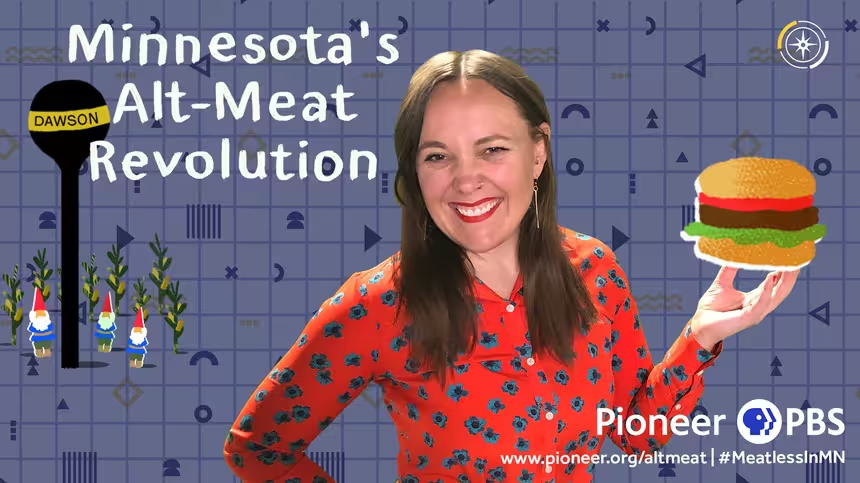
Minnesota’s Alt-Meat Revolution
“Minnesota’s Alt-Meat Revolution" is a year-long video and print journalism collaboration project, looking into the roots and impact of the plant-protein phenomenon that’s exploding across the globe.Providing Support for PBS.org
Learn Moreabout PBS online sponsorship(whimsical music) - The biggest thing for anybody coming in was like, you know, there was a smell.
Well, as one person said, it's kind of like a pig yard, but I don't agree because I try to tell everybody it's a smell of money.
- Hi, I'm Amanda Anderson and I'm here to ask, did you hit your protein goals today?
More and more people are getting their protein from non-meat sources, and the global plant-based protein market is anticipated to hit $17.4 billion by 2027.
I'm exploring the roots and impact of the plant protein phenomenon that's exploding across the globe.
And a key part of that is playing out right here.
Dawson, Minnesota is an agricultural town located in rural southwest Minnesota, population about 1,500 - And it's mostly soybeans and corn, and there's a lot of corn plants in the area also producing ethanol and it's pretty open country so the wind blows around pretty good and we get some snow that blows around occasionally, it gets pretty deep.
- Occasionally (laughs).
Affectionately known as Gnome Town to locals, these gnomes over here represent the founders of Dawson Mills, the company that was the originator of Dawson's signature smell.
There is a hint of money, but the main smell, it's soybeans.
You see, Dawson, Minnesota has played an important role in plant processing and in the development of plant-based proteins which, as you may know, are having a moment.
(triumphant music) - [Narrator] Plant-based meat or fake meat, as some might call it, is wildly popular.
- So good.
- So let's work through how we got to here.
Nadia Bernstein is a historian of food technology.
- So vegetarianism and diet that avoid flesh or certain kinds of meat have been around for since antiquity.
And there's a lot of reasons for vegetarian diets, spiritual, ethical, religious, concerns about health that have existed through history.
- [Amanda] Our history starts in the Midwest where Henry Ford applied his ideas about industrial efficiency into plant-based products.
Ford was a vegetarian and a huge backer of soy anything, like check out his soy suit and soy car.
He worked with George Washington Carver to develop industrial applications of organic materials, a study that was referred to as chemurgy.
Carver also promoted soybean products as food for humans, not just for animals, an idea that Ford shared.
Applying his industrial efficiency ideology, Ford was like, if cows are making milk from eating soy meal, why not just skip the cow and get milk from plants?
In the 1940s, Ford's food scientist, Robert Boyer, developed a way to make a fiber-spun soy product that was initially used for textile fibers like the suit.
- The future of this technology was actually thinking beyond textiles.
Boyer patented his technology for protein spinning.
An entity that licensed this patent was General Mills.
They had over 50 scientists and technicians working on this.
Millions of dollars were invested in this in the sixties.
They were essentially these bland, kind of chewy, blank canvases that could take on, you know, properties of different sorts of meat.
General Mills called this product Bontrae.
They were positioning Bontrae as a product that would benefit a world that was on the verge of environmental catastrophe.
- People weren't thinking about climate change like we think about it today.
The concern then was this very problematic concept called the population bomb.
Fiber spinning was GM's solution for an increasing world population that would be too taxing for meat production.
But even though in the 1970s, when the cost of meat was really high, people didn't want Bontrae so people didn't buy Bontrae.
So GM disassembled their protein spinning facility in Cedar Rapids, Iowa.
- [Nadia] That's where Dawson Mills comes in.
- Before it was called Dawson Mills, it was the Tri-County Cooperative Soybean Processing Association located in Dawson, Minnesota, a.k.a, the town that reeks of money to some.
In October of 1954, four forward thinking business people in town started talking about the business potential of soybean processing.
They met for coffee in the local cafe and decided... - Maybe they should look into establish some kind of a processing plant here.
- [Amanda] This brain trust studied soybean processing and in 1951, opened the Tri-County Cooperative Soybean Processing Association.
- It was fraught with challenges all the way through.
- [Amanda] From too much rain to financial instability, the plant experienced a number of growing pains but the main complaint came from cows.
The plant used an extraction process to separate out the soybean oil.
Once the oil was extracted, what was left was a soy meal cake that was mostly used for feeding cattle.
That soy cake had a huge downside, it was killing the cows that ate it.
The plant had to temporarily shut down while it fixed the problem and reopened in 1953.
In the late 50's, things pick up and soybeans take off.
Dawson started a soybean based festival in 1959.
This pancake flipping contraption was arguably as hot as the pancakes themselves.
- That was a big event in Dawson when they made the pancakes using soy batter.
The grills had eight different plates on them like a carousel.
The first one would put the batter on, and it would go around and they would flip 'em as they went.
And it brought in people from all over the state to see this.
- Bernice worked her way into the trade room where they would buy and sell soybeans.
That's her right there.
So it looks like it's a room full of men and you.
- It was (laughs).
- [Amanda] And by 1960, business almost doubled and the world got its first National Princess Soya in 1968.
In 1969, the Tri-County Cooperative Soybean Processing Association renamed to the less descriptive but easier on the tongue Dawson Mills.
Dawson Mills had been making soy flour for the government's Food for Peace program, but... - They wanted to go a little further than that and also extract the protein and maybe get into a market where they would take this protein and use it as a substitute in for animal protein.
- I don't know of anybody else that was doing isolating proteins other than whatever General Mills was doing.
And Dawson Mills bought that plant equipment from them.
- Dawson Mills also bought the rights from General Mills for Bontrae.
We all know Bontrae now.
In the heart of soybean country, Dawson Mills thought they could do what General Mills couldn't, market the meatless meat.
This meant a bigger plant.
Dawson Mills was located in the heart of town and expansion was nearly impossible.
So they headed east, like two and a half miles east.
- [Bernice] This was a sketch of the plants.
- So this would've been 1970's... - Seven.
- 1977.
Obviously, look at those pants.
- [Bernice] Yeah.
(laughs) - It was supposed to cost like 12 and a half million dollars to build it and it got 20 million plus.
So it was very difficult start and I mean there was a lot of talk about plant-based protein back in those days.
They must have saw this coming and thought it's worth the try.
You know, risk and reward.
- [Amanda] But they stuck with it trying to market what they were calling Anaprime, fiber spun protein that had chicken, beef, and ham flavors.
- The ham and the chicken was pretty good.
It worked great in salads.
The beef was a little, you know, maybe if you used it, I'm not sure what.
- That's his Minnesota nice way of saying people didn't like it, again.
So Dawson Mills found itself in a General Mill situation.
Their 20 million building wasn't producing a product that people wanted in 1979 or even knew how to use, it seemed to Bernice.
- We thought we're really gonna be doing something here and expanding and be helping the farmers out.
And I think maybe if we could have exposed people more to how to use it and what was really involved, it would've been better but that's hindsight, you just don't know.
- By May of 1981, Dawson's meatless meat dreams had come to an end, but their bean processing remained successful.
And in 1984, after another merger, Ag Processing Inc or AGP took the reins and today is one of the largest employers in town.
But that soy isolate building though, it also remained sitting alone in a field 2.5 miles east of town.
From 1982 until 2012, it was an AMPI facility processing cheese sauces and other foods.
When it closed, 130 people lost their jobs in Dawson.
But what's old is new again.
- [Broadcaster] If you haven't yet heard of PURIS, you will.
- [Speaker] Our company is known for pea protein.
- [Broadcaster] The ag tech company based in Minneapolis and run by a brother sister duo was just named by Fast Company as one of the world's most innovative companies of 2021.
(upbeat music) - [Amanda] And just like that, the facility in the field has new tenants and wouldn't you know it, with the company that manufactures plant-based pea protein, PURIS.
Had it not been for the foresight of a few local people trying to think differently about plant proteins or really, how they could get more value out of their soybeans, PURIS wouldn't have a facility to move into.
- It's almost like Thomas Edison, he, you know, he tried the filaments and the bulbs probably 400 times before he got what would work.
- The vegetable protein, I think it's something that's up and coming and when you're thinking about farmers, you know you're gonna be, are you yip yip hooray for the ones producing the vegetable protein?
Or are you yip hooray for the ones that are producing the animal protein?
- How will the rise of plant proteins fit into our current agricultural, cultural, and dietary landscape?
Do you have to be yip yip hooray for one or the other?
Or is coexistence a possibility?
- I don't know if we're ever gonna convert totally to plant-based protein and get rid of our animals.
So I'm thinking that's gonna be a long, long time away.
- [Amanda] Would you consider doing Meatless Monday?
- (grunts) I'd have to think about it.
I could try it (laughs).
- [Amanda] With a 75 million investment in PURIS from Cargill, could meatless meat in Dawson finally be a thing?
In our next episode, we'll look at the landscape of plant-based protein manufacturers in Minnesota with a specific focus on the PURIS promise.
Minnesota's Alt-Meat Revolution: Chews Wisely
Video has Closed Captions
Clip: S7 Ep1 | 11m 39s | Learn about the regenerative potential of beef cattle from two Minnesota farmers. (11m 39s)
Minnesota's Alt-Meat Revolution: Chews Wisely
Preview: S7 Ep1 | 30s | Explores the impact of the food that we eat on soil quality. (30s)
Minnesota's Alt-Meat Revolution: Everybody Loves Jobs
Preview: S7 Ep1 | 30s | In episode five of Minnesota’s Alt-Meat Revolution, we explore the impact of PURIS. (30s)
Minnesota's Alt-Meat Revolution: Give Peas a Chance?
Video has Closed Captions
Clip: S7 Ep1 | 12m 57s | Find out why farmers do — and do not — grow PURIS' yellow field pea. (12m 57s)
Minnesota's Alt-Meat Revolution: What's for Dinner?
Video has Closed Captions
Clip: S7 Ep1 | 11m 27s | Has the presence of PURIS driven people in Dawson to eat more plant-based proteins? (11m 27s)
Minnesota's Alt-Meat Revolution: Give Peas a Chance?
Preview: S7 Ep1 | 30s | A farmer who grows peas for PURIS in ND and why there aren’t more peas grown in MN (30s)
Minnesota's Alt-Meat Revolution: The Great Burger Taste-Off
Video has Closed Captions
Clip: S7 Ep1 | 12m 26s | Learn about PURIS, the largest processor of yellow pea protein in North America. (12m 26s)
Minnesota's Alt-Meat Revolution: The Great Burger Taste-Off
Preview: S7 Ep1 | 30s | Learn about PURIS, the largest processor of yellow pea protein in North America. (30s)
Minnesota's Alt Meat Revolution
Preview: S7 Ep1 | 30s | How will the small ag town of Dawson, MN be impacted by the plant-based protein revolution (30s)
Minnesota's Alt-Meat Revolution: Everybody Loves Jobs
Video has Closed Captions
Clip: S7 Ep1 | 9m 19s | PURIS brought 100 new jobs to Dawson, but is there more to sustainable community growth? (9m 19s)
Providing Support for PBS.org
Learn Moreabout PBS online sponsorship
- News and Public Affairs

Top journalists deliver compelling original analysis of the hour's headlines.

- News and Public Affairs

FRONTLINE is investigative journalism that questions, explains and changes our world.












Support for PBS provided by:
Compass is a local public television program presented by Pioneer PBS
